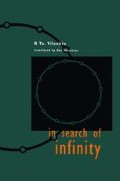Abstract
The study of stone figures and of drawings, made on cave walls with ochre and charcoal, shows convincingly that tens of thousands of years ago humans not only collected information about animals and birds, about properties of grasses and fruits, but also tried to establish regularities in the world around them and to understand its origins. This is how the oldest myths arose: myths about the “Great Original Mother,” the common ancestor of humans and animals, and about totems — protectors of tribes. Ancient humans attributed menacing natural phenomena — thunder, lightning, earthquakes and hurricanes — to the influence of otherworldly forces.
Access this chapter
Tax calculation will be finalised at checkout
Purchases are for personal use only
Preview
Unable to display preview. Download preview PDF.
References
Thaies of Miletus (c. 625–547 BC). Ancient Greek mathematician and astronomer. The first to introduce the notion of proof into mathematics. Proved some very simple geometric theorems.
Anaximander of Miletus (c. 585–525 BC). Ancient Greek philosopher. Student of Thales. First to make the conjecture about the infinity of worlds and of the universe.
Weyl, Hermann (1885–1955). German mathematician. Author of important works on mathematical analysis, differential geometry, algebra and number theory. Interested in the philosophy of mathematics. One of the founders of intuitionism.
Leucippus (c. 500–440 BC). Ancient Greek philosopher, atomist.
Epicurus (c. 341–271 BC). Ancient Greek philosopher, atomist.
Zeno of Elea (c. 490–430BC). Ancient Greek philosopher and author of paradoxes that constituted a critique of notions such as multiplicity, infinity, motion, and (a naive view of) the continuum.
Diogenes of Samos (413–323 BC). Ancient Greek philosopher.
Fraenkel, Abraham (1891–1965). German mathematician. Author of works on mathematical logic.
Naan, Gustav Ivanovich (b. 1919). Soviet philosopher. Interested in the philosophy of science.
Antiphon (second half of the fifth century BC). Ancient Greek philosopher-sophist.
Eudoxus of Cnidos (c. 408- c. 355 BC). Ancient Greek mathematician and astronomer, author of a theory of incommensurable magnitudes and of the “method of exhaustion” for proving theorems on areas and volumes.
Hypatia of Alexandria (370–415). Philosopher, mathematician and astronomer. Lynched by a fanatical Christian mob incited by bishop Cyril of Alexandria.
Albert the Great (c. 1193–1280). German philosopher, naturalist, theologian and logician. Attempted to adapt Aristotle’s teachings to theology.
Bradwardine, Thomas (1300–1349). English mathematician, author of Tractatus de continuo. First to use the word “irrational” in a mathematical sense.
Baconthorpe, John. English scholastic of the 14th century.
Cusa, Nicholas (1401–1464). German philosopher and theologian. His works prepared the ground for Renaissance pantheism and created premises for the justification of the notion of infiniteness of the Universe.
Cavalieri, Bonaventura (1598–1647). Italian mathematician, student of Galileo, and author of a method of indivisibles for finding areas and volumes.
Fontenelle, Bernard (1657–1757). French author and popularizer of science. One of the pioneers of the philosophy of the Enlightenment.
D’Alembert, Jean (1717–1783). French mathematician, mechanician and philosopher. One of the creators of mathematical physics.
Abel, Niels (1802–1829). Norwegian mathematician. Proved the un-solvability in radicals of the general quintic. One of the creators of the modern criteria of rigor in mathematical analysis.
Cauchy, Augustin-Louis (1789–1857). French mathematician. Author of the theory of functions of a complex variable. Developed mathematical analysis based on the limit concept.
Gauss, Carl (1777–1855). The greatest German mathematician of the 19th century. Obtained many fundamental results in algebra, geometry, number theory, and mathematical analysis.
Schumacher, Heinrich (1780–1850). German astronomer.
Riemann, Bernhard (1826–1866). German mathematician. Obtained many outstanding results in the theory of functions of a complex variable, in geometry, and in other areas of mathematics. One of the creators of the concept of a multidimensional space (Riemannian geometry).
Lobachevski, Nikolai Ivanovich (1792–1856). Russian mathematician. Creator of non-Euclidean geometry.
Fridman (Friedmann), Aleksandr Aleksandrovich (1888–1925). Soviet physicist and cosmologist.
Lemaitre, Georges (1894–1966). Belgian astronomer and astrophysicist. Author of the theory of an expanding Universe.
Sitter, Willem, de (1872–1934). Dutch astronomer. Pioneered the application of relativity theory to cosmology.
Slipher, Vesto (1875–1969). American astronomer. First to measure radial velocities of galaxies.
Hubble, Edwin, (1889–1953). American astronomer. Showed that galaxies are systems of stars.
Doroshkevich, Andrei Georgievich (b. 1937). Soviet physicist and cosmologist.
Novikov, Igor Dmitrievich (b. 1935). Soviet astrophysicist and cosmologist.
Brillouin, Leon (1889–1969). French physicist. Author of works on quantum mechanics, information theory, and philosophy of science.
Zelmanovich, Abram Leonidovich (b. 1913). Soviet cosmologist.
Rights and permissions
Copyright information
© 1995 Springer Science+Business Media New York
About this chapter
Cite this chapter
Vilenkin, N.Y. (1995). Infinity and the universe. In: In Search of Infinity. Birkhäuser, Boston, MA. https://doi.org/10.1007/978-1-4612-0837-2_1
Download citation
DOI: https://doi.org/10.1007/978-1-4612-0837-2_1
Publisher Name: Birkhäuser, Boston, MA
Print ISBN: 978-1-4612-6915-1
Online ISBN: 978-1-4612-0837-2
eBook Packages: Springer Book Archive

